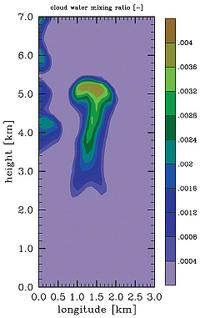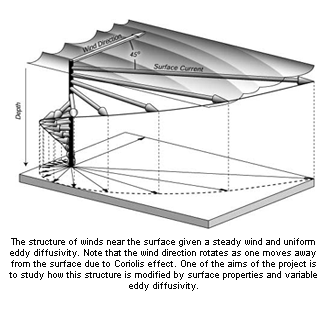Atmospheric dynamics
The fundament of our theoretical studies to characterize a variety of scale-dependent phenomena in the atmosphere is a unified approach [1,2,3,4], which is based on multiple-scales asymptotics. [5], Important results achieved up to now are
Theory:
- Model equations for atmospheric motions on planetary spatial scales [6,7,8], as they are relevant for applications in the climate research, [9],
Change in mean air temperature
at ground level in 2100 for a standard scenario of carbon dioxide emissions.
(Picture provided by
S. Rahmsdorf, PIK Potsdam)
- a theory for the temporal evolution of cyclones, which incorporates the interaction between the internal flow structure, the background flow, and the inclination of the centerline with respect to the vertical. Furthermore, it results in the determination of the effective direction of motion and the vortex speed, [10,11],
- two mathematical models for the evolution of deep convective clouds and their interaction with the surrounding atmosphere, [12,13,14,15],
Theory and Simulation of Deep Convective Clouds
Clouds play a decisive role in both the daily weather pattern and the long-term climate variation. They constitute a moisture reservoir carried by the wind and represent the preliminary stage of precipitation. By reflection, absorption, and transmission of electromag-netic waves in the visible and infrared spectra they influence directly the atmosphere's heat budget.
For theory development and computer simulation clouds pose a particular challenge since they are determined by the interaction of a multitude of individual processes. Some of them take place in the size range of small cloud droplets (micrometres), some in the size range of typical turbulent flow fluctuations (metres), some in the size range of characteristical cumulus clouds (one to ten kilometres). Large stratocumulus cloud layers above the oceans even span several thousands of kilometres. For this reason cloud processes belong to the class of multi scale phenomena investigated intensely by natural scientists and mathematicians these days.
Please click here to see more
- reduced model equations describing the structure and temporal evolution of different types of atmospheric boundary layers. This includes, in one case, the analysis of model uncertainties, [16,17,17a],
Effects of surface properties on atmospheric boundary layer flows
This project is concerned with a systematic study of effects of the underlying surface on atmos-pheric flows and to quantify the impact of uncertainties in surface properties on the accuracy of the boundary layer models. The multiscale asymptotic method is used to model the boundary layer processes capturing the spatial and temporal scales of interests together with the nonlinear interactions therein. The polynomial chaos method is used in the characterization of the uncertainty in the flow quantities as functions of random model inputs such as surface roughness uncertainty.
One of the goals of this investigation is to improve on the representation of boundary layer processes in numerical models and also suggest appropriate coupling strategies between a boundary layer model and the free atmosphere model. We hope that this will lead to a more accurate weather prediction and climate forecasts.
- a critical discussion [18], of well established so called "soundproof" models (where no sound waves are present). This includes different versions of anelastic models [19,20,21,22]and the pseudo-incompressible model[23].
- stochastic models, which efficiently represent certain aspects of weather statistics and planetary fluid mechanics relevant for our climate, [24,25,26,27].
[ 1] Klein, R. (2004) An applied mathematical view of meteorological modeling. Applied Mathematics Entering the 21st century; Invited talks from the ICIAM 2003 Congress., 116 . pp. 177-219.
[ 2] MetStroem lecture notes
[ 3] Klein, R. (2008) An Unified Approach to Meteorological Modelling Based on Multiple-Scales Asymptotics. Advances in Geosciences, 15 . pp. 23-33.
[ 4] Klein, R. (2010) Scale-Dependent Asymptotic Models for Atmospheric Flows. Annual Review of Fluid Mechanics, 42 . (In Press)
[ 5] Schneider, W. (1978) Mathematische Methoden in der Strömungsmechanik, Vieweg
[ 6] Majda, A.J. and Klein, R. (2003) Systematic Multiscale Models for the Tropics. Journal of Atmospheric Sciences, 60 pp. 393-408.
[ 7] Dolaptchiev, S. (2008) Asymptotic models for planetary scale atmospheric motions (phdthesis) Freie Universität Berlin
[ 8] Dolaptchiev, S. and Klein, R. (2009) Planetary geostrophic equations for the atmosphere with evolution of the barotropic flow. Dynamics of Atmospheres and Oceans Volume, 46 (1-4). pp. 46-61
[ 9] Petukhov, V. Et Al (2000)
CLIMBER-2: A climate system model of intermediate complexity. Part I: Model description and performance for the present climate, Journal Climate Dynamics, Volume 16, pp 1-17
[10] Mikusky Dissertation
[11] Mikusky, E. and Owinoh, A.Z. and Klein, R. (2005) On the influence of diabatic effects on the motion of 3D-mesoscale vortices within a baroclinic shear flow. In: Third MIT Conference on Computational Fluid and Solid Mechanics, June 14-17, 2005.
[12] Carqué, G. (2009) Derivation and Validation of an Asymptotic Column Model for Deep Convective Precipitating Clouds. PhD thesis, Freie Universität Berlin.
[13] Carque et al. ZIB/Reports; Carqué, G. and Schmidt, H. and Stevens, B. and Klein, R. (2008) Plausibility Check of an Asymptotic Column Model for Deep Convective Clouds. ZIB-Report, 08 (44)
Carqué, G. and Owinoh, A.Z. and Klein, R. and Majda, A. J. (2008) Asymptotic Scale Analysis of Precipitating Clouds. ZIB-Report , 08-03 . ISSN 1438-0064
[14] Majda, A. J. and Klein, R. (2006) Systematic Multiscale Models for Deep Convection on Mesoscales. Theoretical and Computational Fluid Dynamics, 20
[15] Ruprecht, D. and Klein, R. and Majda, A. J. (2009) Moisture - Gravity Wave Interactions in a Multiscale Environment. Journal of Atmospheric Sciences. Technical Report. Konrad Zuse Zentrum Berlin.
[16] Owinoh, A.Z. and Hunt, J. and Orr, A. and Clark, P. and Klein, R. and Fernando, H. and Nieuwstadt, F. (2005) Effects Of Changing Surface Heat Flux On Atmospheric Boundary-Layer Flow Over Flat Terrain. Boundary Layer Meterology, 116 (2). pp. 331-361.
[17] Klein R., Mikusky E., Owinoh A. (2005) Multiple Scales Asymptotics for Atmospheric Flows,
in: 4th European Conference of Mathematics, Stockholm, Sweden, 2004, Ari Laptev (ed.), 201--220; European Mathematical Society Publishing House,
[17a] Schmidt, H. and Oevermann, M. and Bastiaans, R.J.M. and Kerstein, A.R. (2009) A priori Tabulation of Turbulent Flame Speeds via a Combination of a Stochastic Mixing Model and Flamelet Generated Manifolds, Extended to Incorporate Strain Effects. ZIB Report, 09-09 . ISSN 1438-0064
[18] Klein, R. (2009) Asymptotics, structure, and integration of sound-proof atmospheric flow equations. Theoretical and Computational Fluid Dynamics, 23 (3). pp. 161-195. ISSN 0935-4964 (Print) 1432-2250 (Online)
[22] Bannon, P.R. (1996) On the anelastic approximation for a compressible Atmosphere (article)
Journal J.Atmosph.Sci., 53, pp 3618--3628
[23] Durran, D.R. (1989) Improving the anelastic approximation (article)
Journal of Atmosphere Sciences, 46, pp 1453--1461
[24] Petoukhov, V. and Eliseev, A. and Klein, R. and Oesterle, H. (2008) On the statistics of the free-troposphere synoptic component. Part I: An evaluation of skewnesses and estimation of the third-order moments contribution to the synoptic-scale dynamics and meridional fluxes of heat and humidity. Tellus, 60 (1). pp. 11-31.
[25] Horenko, I. and Dolaptchiev, S. and Eliseev, A. and Mokhov, I. and Klein, R. (2008) Metastable Decomposition of High-Dimensional Meteorological Data with Gaps. Journal of the Atmospheric Sciences, 65 (11). pp. 3479-3496.
[26] Horenko, I. and Klein, R. and Dolaptchiev, S. and Schütte, Ch. (2008) Automated Generation of Reduced Stochastic Weather Models I: Simultaneous Dimension and Model reduction for Time Series Analysis. Mult. Mod. Sim., 6 (4). pp. 1125-1145.
[27] Franzke, Ch. and Horenko, I. and Majda, A. J. and Klein, R. (2009) Systematic Metastable Atmospheric Regime Identification in an AGCM.Journal for Atmospheric Sciences, 66 . pp. 1997-2012.




